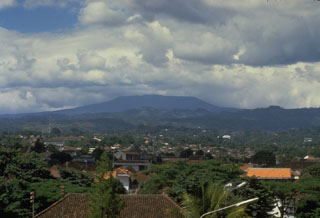Report on Tangkuban Parahu (Indonesia) — 31 December-6 January 2015
Smithsonian Institution / US Geological Survey
Weekly Volcanic Activity Report, 31 December-6 January 2015
Managing Editor: Sally Sennert.
Please cite this report as:
Global Volcanism Program, 2014. Report on Tangkuban Parahu (Indonesia) (Sennert, S, ed.). Weekly Volcanic Activity Report, 31 December-6 January 2015. Smithsonian Institution and US Geological Survey.
Tangkuban Parahu
Indonesia
6.77°S, 107.6°E; summit elev. 2084 m
All times are local (unless otherwise noted)
PVMBG reported that white plumes rose at most 50 m above Tangkubanparahu's Ratu Crater during October-December 2014. Deformation data showed changes and seismicity increased. On 31 December the Alert Level was raised to 2 (on a scale of 1-4). Residents and tourists were warned not approach the crater within a radius of 1.5 km.
Geological Summary. Gunung Tangkuban Parahu is a broad stratovolcano overlooking Indonesia's former capital city of Bandung. The volcano was constructed within the 6 x 8 km Pleistocene Sunda caldera, which formed about 190,000 years ago. The volcano's low profile is the subject of legends referring to the mountain of the "upturned boat." The Sunda caldera rim forms a prominent ridge on the western side; elsewhere the rim is largely buried by deposits of the current volcano. The dominantly small phreatic eruptions recorded since the 19th century have originated from several nested craters within an elliptical 1 x 1.5 km summit depression.
Source: Pusat Vulkanologi dan Mitigasi Bencana Geologi (PVMBG, also known as CVGHM)

